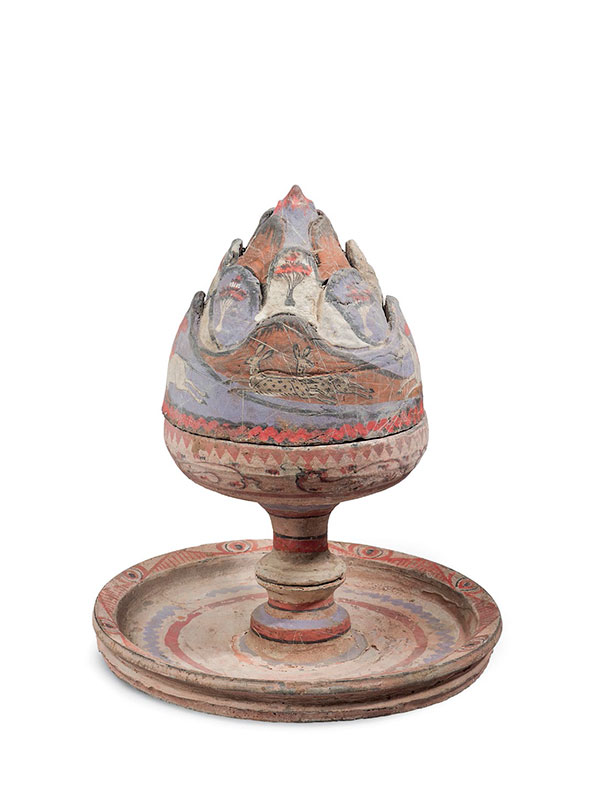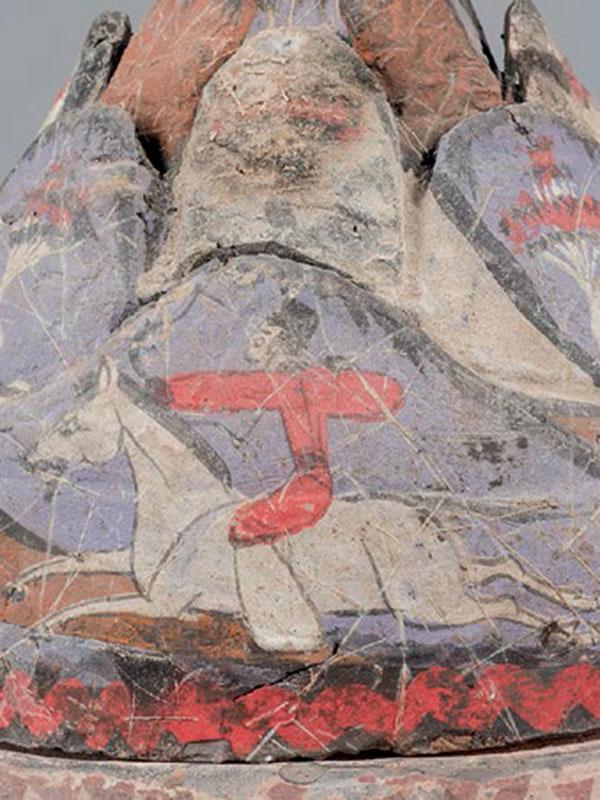Painted pottery incense burner boshanlu, with hunting scene
A grey pottery incense burner, the cup-shaped basin supported on a knobbed, hollow stem, which itself rests on a dish with everted rim. The conical openwork cover is modelled as a range of overlapping mountain peaks, interspersed with a number of small cavities. The incense burner is covered in a layer of thin white slip and painted in great detail with purple, red, black and orange pigments. The cover depicts two hunters on horseback, chasing at full stretch a wild boar and two deer, one of which turns its head around to glance back at the hunter. Each mountain peak is painted with a single tree. The basin and dish-shaped stand are decorated with bands of formal and geometric pattern.
The boshanlu, meaning ‘mountain censer’, was popular during the Western Han dynasty as a representation of the idyllic, mountainous realm of the Immortals, but does not seem to have existed prior to that period.[1] Han dynasty pottery shapes usually have parallels in metal; a particularly sumptuous prototype for this pottery incense burner, inlaid in gold, is in the Hebei Provincial Museum.[2] Examples of similar shape in both glazed and unglazed pottery are relatively common, but this boshanlu is extremely unusual for its well-retained, vividly bright colour painting scheme and the life-like depiction of a hunt. An unglazed boshanlu moulded with hunting scenes in high relief, dated to the Han dynasty, is in the Julius Eberhardt collection in Vienna.[3] Two green-glazed examples with comparable hunting scenes, dated later to the Eastern Han dynasty, 1st or 2nd century AD, are in the Meiyintang collection.[4] A Western Han brick relief depicting hunting scenes in mountains, similarly including hunters on horseback chasing boars and deer, was unearthed at Luoyang, Henan province.[5] A large Western Han pottery jar painted with a mounted archer chasing a tiger is in the Meiyintang collection.[6]
Provenance: Private collection, Europe
- Yang, Xiaoneng ed. The Golden Age of Chinese Archaeology; Celebrated Discoveries from the People’s Republic of China, National Gallery of Washington, 1999, p, 402
- Yang, Xiaoneng ed. op. cit. no. 134, pp. 402-3
- Krahl, R. Sammlung Julius Eberhardt, Frühe chinesische Kunst/Early Chinese Art, Vienna, 1999, no. 95, p. 158
- Krahl, R. Chinese Ceramics in the Meiyintang Collection, Volume Three (I), Paradou Writing, London, 2006, nos. 1151&1152, p. 145
- Shi, Jia Zhe; Li Juan, ‘The New Discovery of Bricks Relief of Western Han Dynasty’ in Cultural Relics of Central China, 2005, Issue 6, p. 10, pl. 4
- Krahl, R. Chinese Ceramics in the Meiyintang Collection, Volume One, Azimuth Editions, London, 1994, no. 60, pp. 57-9
彩繪博山爐
西漢 西元前206年 – 西元9年
高:23.5 公分 盤底徑:20.3 公分
泥質陶爐,子母口,扁圓腹,器腹下方急收,連接階狀圓柱,下皆承盤。蓋成圓錐狀,立體表現
層疊山巒與雲氣,並鏤空以為山洞。盤敞口,淺腹,平折沿,平底。爐蓋與承盤均施彩繪,蓋周
身繪有兩位獵人騎馬於山林間追捕野豬與羚羊,爐腹繪以雲氣紋,細節描繪與彩料色澤均保存良
好,含橘紅、藍紫、乳白、棕黃及墨黑等色,彌足珍貴。博山爐於漢代時稱為「薰爐」,原用途
為燃香薰衣。一般實用香爐為銅質,陶質應為陪葬之用。山林狩獵圖常用以裝飾漢代器物,如河
南洛陽出土之畫像磚即有類似構圖。玫茵堂藏有兩件綠釉陶博山爐,爐蓋模印山林狩獵圖,可為
比較。
來源: 歐洲私人收藏


